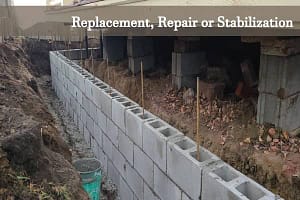Some Ideas on Best Basement Waterproofing You Need To Know
Some Ideas on Best Basement Waterproofing You Need To Know
Blog Article
10 Easy Facts About Best Basement Waterproofing Shown
Table of ContentsThe Main Principles Of Best Basement Waterproofing The Ultimate Guide To Best Basement WaterproofingBest Basement Waterproofing Can Be Fun For EveryoneUnknown Facts About Best Basement WaterproofingWhat Does Best Basement Waterproofing Mean?
usages excavation techniques toward all-time low of the framework's structure. involves removing moisture after it has actually gotten in the basement. AdvantaClean's qualified specialists and service technicians will certainly locate the water source. If wall surface or slab fractures are present, we will inject polyurethane and epoxies right into the fractures and seal the concession, preventing additional wetness from getting in.If there's condensation outside of the aluminum foil, you have high moisture in your basement. Repair it with a portable space dehumidifier or a whole-house humidifier system rather than waterproofing items. If the foil has condensation on the within surface area (next to the wall surface), the soil around your house might be naturally damp from a high water table or inadequate dirt drain.
You can waterproof just your indoor wall surfaces, which may resolve the problem. Once they dry, they stick permanently to concrete and masonry wall surfaces.
The 10-Second Trick For Best Basement Waterproofing
Concrete waterproof coatings can not be used to previously painted surface areas; examine the tag. Known as densifiers, they are appropriate only for walls that haven't been painted or secured.
Yet you comb, roll, or spray it on far more thickly one gallon covers simply 75 square feet, not the 300 square feet typical with basic paint. Waterproof paint is great for do it yourself application. You can apply it over repainted surface areas, and paint over it once it's cured (one gallon costs $37).
It can set you back $10,000 to $15,000, relying on the work required. Outside waterproofing entails digging deep into all over your home fully deepness of the foundation wall surfaces, after that setting up a water resistant layer or membrane layer topped by drain panels. The panels offer a very easy course for water to stream to an outside French drainpipe at the base of your foundation.
We have actually all been captured in a storm without umbrella or raincoat (Best Basement Waterproofing). And it's always a dish for disaster: every little thing's wet, your coiffure is spoiled, and things are obtaining musty. A cellar without waterproofing is sort of like that. Minus the messed up hairdo part. Your cellar doesn't desire to experience a downpour without appropriate defense equally as high as you don't intend to.
How Best Basement Waterproofing can Save You Time, Stress, and Money.
But if you've done your research study, you would certainly understand there are 2 sorts of waterproofing: exterior and interior. It can get confusing what they both mean, which one's a better investment, and what will really keep the water out. Don't worry, we placed together this blog to conveniently specify both approaches for you and review the benefits and drawbacks of each.
Outside waterproofing is a waterproofing technique that involves sealing your home from the outside. The structure wall surfaces are after that cleaned up, sealed, and covered with a water-proof membrane or sealant.

The Main Principles Of Best Basement Waterproofing
It's a much more engaged process that needs excavating up your yard, which is pricey and read more lengthy. Outside waterproofing includes getting rid of everything surrounding the residence, including patios, driveways, sidewalks, landscape design, air conditioning systems, decks, and so forth. If any of the job was done incorrectly and water is still entering your basement, there isn't much you can do to correct or fix it.
Inside basement waterproofing includes waterproofing from the inside. Any type of water that leakages into your basement is redirected before it touches your floor.
It's a reliable view publisher site method to water resistant your cellar - Best Basement Waterproofing. The disadvantage of interior cellar waterproofing primarily pertains to the setup procedure. This method needs saved things, furniture, and integrated shelving or closets to be relocated from touching the cellar walls. And during setup, your cellar can not be made use of. The most significant difference between both approaches is this: Exterior waterproofing is a preventative solution and interior waterproofing is a corrective remedy.
Best Basement Waterproofing Things To Know Before You Get This
To conclude, exterior and interior basement waterproofing are both reliable methods of protecting your home from water damages. Exterior waterproofing produces a barrier that prevents water from entering your home, while indoor waterproofing redirects water that does enter your home. And it's important to note that outside waterproofing is a costly and disruptive installation procedure when compared to interior waterproofing.
Whichever method you pick, ensure you pick a dependable and credible contractor for the work. Both methods call for seasoned workers to handle the task. If you have Check Out Your URL any questions regarding cellar waterproofing, please connect to us. And if you remain in our solution area and have water in your cellar, contact us for a cost-free, no-obligation home assessment.
You can fill in our form right here, begin a chat in the lower right-hand corner, or call us at 1-800-827-0702.
Report this page